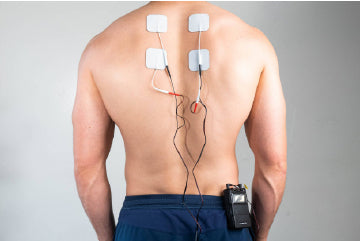15 Ways to Relieve Back Pain

15 Ways to Relieve Back Pain
According to experts, nearly 65 million adults in America report experiencing a recent episode of back pain. Additionally, around 16 million adults (around 8%) experience chronic back pain and are limited in what they can do.
Back pain can be an indication of a variety of illnesses and conditions. The primary cause of the pain may be in the back or another part of the body. Many times, physicians are unable to find a cause for the pain. When they do, some of the common explanations include:
- Stress/injury, including strain/sprain
- Disease/injury involving the vertebrae, including from an accident or as a result of osteoporosis
- Arthritis, "wear & tear," related to genetic predisposition, injury, and age
- Disease/injury involving spinal nerves, including bulging disc or spinal stenosis
- Kidney stones/infection
Some of the rare causes of back pain include:
- Inflammatory arthritis, such as ankylosing spondylitis and other similar conditions
- Spinal tumor or cancer that has spread to the spine from elsewhere
- Infection in the disc space, pelvis, bone, abdomen, or blood
Now that we’ve looked at some of the potential causes of back pain, let’s look at some of how you can relieve back pain.
No matter what is causing it back, pain can be uncomfortable at best and unbearable at worst. Below, we will explore 15 ways to relieve your back pain.

Get a Good Night's Sleep
One of the best ways to recover from anything is to get a good night's sleep. However, when dealing with back pain, that can be hard (and sometimes impossible). It turns into a cycle because when you don't sleep, it seems to cause the pain to feel worse- which keeps you from sleeping, and so on.
You can try a natural sleep aid to help you get a good nights’ sleep. Try the following one at a time to see if one helps you:
- Valerian Root
- Vitamins C & B-6
- L-theanine
- Melatonin
It would also help to keep in mind that a poor sleep position can cause back pain to flare up, so try lying on your side with a knee pillow. This will help ensure that your spine remains in a neutral position and relieves strain on your back. If you must sleep on your back, place a pillow under your knees and make sure you have a comfortably firm mattress.

Practice Good Posture
Now that you're older, you wish you had listened to the adults in your life when you were a child. Posture is important- slouching is bad. When you slouch, you can aggravate your back pain- especially if you sit for long periods of time. You should never slump when you're sitting at your keyboard/computer. Sit up straight with shoulders relaxed and body supported by the back of the chair. Your feet should be flat on the floor. Try placing a rolled towel or pillow between the chair and your lower back.

OTC Medications
There are two types of OTC pain relievers that can help with back pain: acetaminophen and NSAIDs or nonsteroidal anti-inflammatory drugs. It's important to note that both do have some side effects, and not everyone can take them. Additionally, one may be more effective than the other for you. Be sure that you consult with your physician before taking any pain relievers, and don't assume that the medication will solve the problem. Research indicates that you will probably need more than one type of treatment.

Prescription Medications
If you have tried OTC medications and are not working, you may need to consult with your physician for prescription-strength NSAIDs or even opioid medications to help with your pain. Of course, you will need to discuss any other medications you are taking with your physician or pharmacist to avoid potentially overdosing on certain ingredients. If you are also experiencing muscle spasms along with back pain, your physician may prescribe muscle relaxers in addition to pain medications.

Prevent with Anti-Inflammatory Drinks
Some research indicates that several antioxidants have anti-inflammatory and anti-cancer properties that build up in your body by consuming anti-inflammatory foods regularly. Over time, these agents can significantly reduce and even eliminate inflammation in your body. Following are a few anti-inflammatory drinks that may help with back pain:
Turmeric Milk
Turmeric is an Asian spice known for its anti-inflammatory, antioxidant, and anti-arthritic properties. One of the easiest ways to consume this spice is by combining ½ teaspoon into a glass of warm milk. If you prefer a sweeter flavor, you can add some honey or stevia. Consume a glass just before bedtime to allow it to work while you sleep. For some people, dairy products increase the inflammatory response of the body. If this is the case, try using almond milk or other plant-based product.
Tart Cherry Juice
Cherries are full of anti-inflammatory and antioxidant properties. Cherry juice may relieve muscle pain, which may be caused by exercise or chronic. Cherry juice is easy to find at your local grocery store and typically contains tart cherry extract. Try consuming a glass of tart cherry juice daily and see if it helps relieve your back pain.
Ginger Green Tea
Finally, you might want to try an herbal-infused beverage, such as Ginger Green tea. This contains the pain-relieving effects of ginger and green tea. You can find Ginger Green tea bags at your local grocery store and enjoy a cup of tea no matter where you are. Over time, the anti-inflammatory agents will build up in your system- which can reduce overall inflammation and prevent new inflammation from occurring.

Antidepressant Medications
Even if you don't feel depressed, some physicians prescribe antidepressant medications as part of the treatment protocol for chronic lower back pain. It's unclear exactly how an antidepressant can treat pain, but it works. Some researchers believe the influence of the antidepressant on the chemical messengers in the body can affect pain signals.

Physical Therapy
A physical therapist can teach you proper sitting posture, standing posture, sleeping posture, and how to move to ensure your spine remains in proper alignment and strain on your back is alleviated. They can also teach you exercises that strengthen your core muscles in your back. One of the best ways to prevent back pain in the future is with a strong core. Studies have proven that increases endurance, strength, and flexibility will decrease back pain- but it won't happen overnight.

Don't Rest Your Back
At one time, bed rest was one of the primary treatments prescribed for back pain. Current research indicates that lying still is one of the worst things you can do. It can cause back pain to worsen and potentially lead to other issues. It would help if you never rested your hurt back for more than a day. You must get moving. One of the most effective ways to quickly relieve back pain is exercise. Some of the best exercises for back pain include yoga, swimming, and walking.
When your back is hurting, regularly applying ice to the painful areas may help with reducing pain and inflammation associated with an injury. Try doing this several times each day for up to 20 minutes. Be sure to place something between the ice pack and your skin to protect yourself from frostbite. After a few days, switch to heat and follow the same procedure. This will help relax the muscles and increase blood flow. You may also want to try warm baths to help you relax. Of course, you should never sleep with a heating pad.

Take a Hands-On Approach
There is some research indicating that massage may help with chronic back pain. One study showed that patients with chronic back pain who got a massage once a week for 10 weeks experienced decreased pain and increased functioning. These benefits lasted for about 6 months but began to dwindle after about a year.
Another option is spinal manipulation. When performed by a licensed specialist (chiropractor), this can help to ease any structural issues associated with the spine and restore any mobility that has been lost.
Nerve Stimulation
There is some research indicating that nerve stimulation can help with reducing chronic back pain. If you are not getting relief from your back pain with conservative care, your physician may consider adding acupuncture to your treatment protocol. Another recommendation your physician might make is a TENS unit or transcutaneous electrical nerve stimulation. This is a process by which mild electrical pulses are delivered to your nerves, blocking out pain signals.
Learn more about using TENS therapy for back pain.

Cognitive Behavioral Therapy
While it's true that seeing a therapist/psychologist for back pain may sound strange, studies have proven that cognitive-behavioral therapy, or CBT, effectively relieves chronic back pain both in the short term and in the long run. For example, CBT can help change the way patients with back pain think about physical activity, making them more active. Some individuals who have had CBT report a substantial decrease in their pain and disability.

Biofeedback
Biofeedback is a process where patients are attached to a machine that helps train the brain to control pain response. It teaches you to moderate breathing, muscle tension, blood flow, and heart rate. According to some research, this process is better than medication when easing back pain, and some studies have shown it reduces the intensity of pain by approximately 30%. The best part is that there are no side effects to worry about as you have with medications.

Spinal Injections
If nothing else seems to be working to ease your back pain, your physician may recommend that you try spinal injections to reduce your back pain. There are several different options that a physician specializing in pain management may recommend. For example, a corticosteroid may reduce the inflammation causing the pain. Depending on the type of injection, your physician may limit how many doses you can have in one year to avoid potential side effects.

Surgery
If nothing else is working, your physician may recommend back surgery. Of course, this should always be a last resort because of the risks associated with surgery. However, if you have a bulging disc that puts pressure on a nerve, your physician may do a discectomy. If you have a compressed disc, your physician may recommend a laminectomy to reduce the pressure. A spinal fusion may be recommended if you need help stabilizing your spine.
Conclusion
A variety of issues cause back pain, which may be a chronic condition or result from your intense workout. There are many ways to treat your back pain, and we have outlined 15 options for relieving back pain.
Back Pain Related Resources
About the Author

Brandon Landgraf is the Digital Marketing Manager for Carex Health Brands. He finds passion and fulfillment in creating content that enhances, improves, and enlivens others' quality of life. All of his written work is formulated to not only offer essential advice and tips but back it with proven studies and experts. His mission is to connect with readers and provide steps to make their lives better.
You can connect with him on LinkedIn here.
About Carex Health Brands
Carex is your one-stop shop for home medical equipment and for products that assist caregivers with providing the best possible support and care for their loved ones. Carex Health Brands has been the branded leader in in-home, self-care medical products for over 35 years. Our goal is to improve the lives of our customers by bring them quality products that bring dignity back to their lives. With our three nationally distributed brands, Carex Health Brands serves national, regional and independent food, drug and mass retailers along with wholesalers, distributors and medical dealers.



